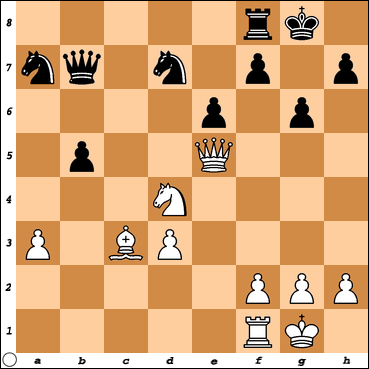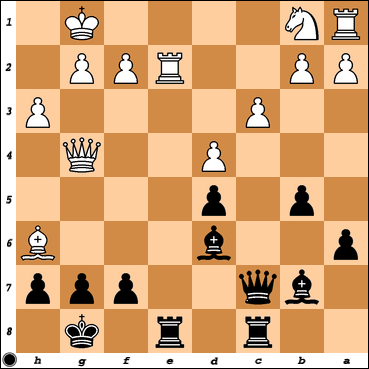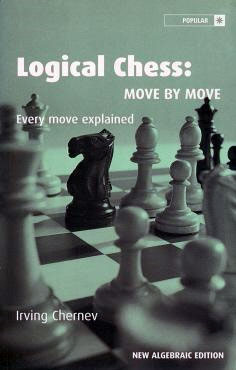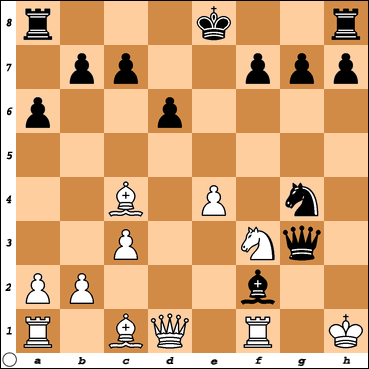Analysis to follow, perhaps. Lots of mistakes made.
Analysis to follow, perhaps. Lots of mistakes made.
Preparing the b4 pawn push, supported by the rook, to be followed up by b5, especially if there is a knight on c6, and a4, grabbing lots of queenside space and waiting for the opponent to commit to placing his pawns in the center before deciding what to do with the central pawns and kingside pieces. Prevents black's king's bishop from developing naturally to c5 or b4, and has the possibility of giving white two nice diagonals to place his bishops on: a3-f8 or a1-h8 and a2-g8. Probably has a high propensity to getting creamed on the kingside, but good for a laugh, especially in 1 minute games, like the following [the same opening idea but reversed, as black].
The same idea as white, accidentally in a 5 minute game, intended for a 1 minute game.

Exciting position from the game Evgeny Sveshnikov vs. Ruslan Scherbakov, 1991. White to move and mate in three.
1. Qg7+!! White sacks his queen to trap black's king in a mating net ... Kxg7 the only move. 2. Nf5++ The double check forces black's king to move and prevents him from escaping via h6 ... Kg8 the only move. 3. Nh6# or 3. Ne7#
From a different game, a tactical puzzle. Black to move and win material. White has just played Bh6.

1 ...f5! Black covers the g7 square with his Queen and simultaneously attacks White's queen, which must protect the rook on e2 as well as pin the g-pawn so that it cannot take the bishop on h6. If 2. Rxe8+ Rxe8 as was played in the game, 3. Qd1 must be played to prevent ...Re8#, losing the bishop. The best line for white is 2. Qh5 Rxe2 3. Qxe2 gxh6 4. Qe6+ Kg7 5. Qxf5 Bh2+ 6. Kh1 (6. Kf1 Qc4+ leads to mate)
Here is a fun game I just played on the Free Internet Chess Server. If you copy-paste this as a PGN into your viewer you can read my comments as well as look at some variations.
[Event "rated blitz match"]
[Site "Free Internet Chess Server"]
[Date "2009.05.08"]
[Round "?"]
[White "waparker"]
[Black "pencsev"]
[Result "1-0"]
[WhiteElo "1171"]
[BlackElo "1048P"]
[ECO "C41"]
[TimeControl "300"]
1. e4 e5 2. Nf3 d6 3. d4 exd4 4. Qxd4 Bg4 5. Rg1 $5 {A cute little move to have some fun that I just came up with. If black takes the knight and opens the g-file, he will basically be forfeiting the right to castle on the kingside, and the development of his dark-square bishop might be difficult due to the pressure on g7. But it's definitely not a very sound idea.} Qf6 6. Qe3 (6. Qb4 Bxf3 7. gxf3 b6 8. Nc3 Qxf3 9. Nd5 Kd8 $16 {If black goes for pawn-grabbing, white will have a lead in development and threats on c7 to force the king to forfeit the right to castle.} ) Nc6 7. Nc3 a6 8. Bd2 (8. Nd5 Qd8 9. Qb3 Rb8 10. h3 Bd7 11. Bd3 ) O-O-O 9. O-O-O Nd4 10. Be2 (10. Nd5 Qg6 11. Qxd4 $18 {A simple tactic to win a piece. The queen can't stay on the diagonal to protect the knight.} ) Nxf3 11. gxf3 Be6 12. Kb1 (12. Qa7 b6 13. Qa8+ Kd7 14. Qxa6 g6 15. e5 Qf5 16. Bb5+ c6 17. Qb7+ $18 ) Kb8 13. Bd3 d5 {Black offers to open up lines when he is the player with poor development.} 14. exd5 Bxd5 15. Nxd5 Rxd5 16. Be4 Rb5 17. Bc3 Qb6 (17. ... Qe7 {A better alternative to the move played which immediately loses;} 18. Rd2 Rb6 19. Ba5 Rd6 20. Qb3 b6 21. Bb4 Qe5 22. Rgd1 Rxd2 23. Rxd2 Qg5 24. Qd3 $18 ) 18. Rd8+ Ka7 19. Qxb6+ (19. Rxf8 Qxe3 20. fxe3 c5 21. Rxg7 ) cxb6 20. Rgd1 (20. Rxf8 f5 21. Bd3 Rd5 22. Bxg7 ) Bc5 (20. ... Be7 21. R8d7 Kb8 22. Bxb7 Bf6 23. Bxa6 Rg5 24. f4 Rg6 {Rybka gives Rg1, sacking the rook to stop white's rook coordination. This more human-like move leads to checkmate.} 25. Be5+ Bxe5 26. Rb7+ Kc8 27. Rxf7+ Kb8 28. Rd8# ) 21. R1d7 a5 22. Rxb7+ Ka6 23. Ra8# {pencsev checkmated} 1-0
Featuring three games: two from me, and one from Paul Morphy, the famous Opera Game.
I achieved my highest blitz rating on FICS last night of 1234. I think making live videos will improve my ability to make plans quickly and avoid indecision. I have actually been winning some five minute games instead of losing on time!
Here is a game from the book Logical Chess: Move by Move by Irving Chernev. Try to go through the moves in your head without looking at a board. It's not a long game so it should be possible.

A highly recommended book.
von Schieve - Teichmann Berlin 1907 - Guioco Piano
1. e4 e5 2. Nf3 Nc6 3. Bc4
This game comes from the "kingside attack" chapter of this book. A good development of the bishop, it is aggressively pointed at f7. It also contests the d5 square.
3 ... Bc5 4. c3
White aims to establish the central pawn duo of e4 and d4. This c-pawn thrust also makes Qb3 an option to attack f7. It does, however, deprive the queenside knight of his best square. The threat is 5. d4 attacking the bishop and forcing 5 ... exd4 6. cxd4.
4 ... Qe7
Black counters the threat by counterattacking on the e-pawn. If 5. d4 exd4 6. cxd4 then 6 ... Qxe4+ wins the pawn.
5. O-O d6 6. d4
White delayed the d4 thrust to castle his king. The move indirectly protects the e-pawn, because 6 ... exd4 7. cxd4 Qxe4 8. Re1! and the queen is pinned and will be lost.
6 ... Bb6
Black's move d6 allows him to retreat his bishop after 6. d4 and not lose his central pawn.
7. a4 a6 8. a5
White is losing time on a fruitless attempt to trap the bishop or fool black. If 8 ... Bxa5 then 9. d5! Nd8 10. Rxa5 wins a bishop. But black does not fall for it.
8 ... Ba7 9. h3
A weak move that I have been seeing alot in blitz games on FICS. White wants to prevent Bg4 pinning the knight, but it is unnecessary. Chernev writes, "It is better to submit to the pin -- a temporary inconvenience -- than to prevent it by a move that looses the position of the pawns defending the king." Now Bxh3 is a constant option for black to trigger a kingside mating attack.
9 ... Nf6 10. dxe5
Black is poorly developed, so opening up lines in the center will favor black. White has just increased the scope of black's a7 bishop, which now pins the f2-pawn to the white king.
10 ... Nxe5 11. Nxe5 Qxe5
Black is right to replace his e-pawn with pieces. Now white's knight on f3 -- the best defender of the white kingside -- has disappeared, replaced by a powerfully placed queen on e5.
12. Nd2
Although the white e-pawn is attacked twice and defended once, taking it would cost the game: 12 ... Nxe4 13. Nxe4 Qxe4 14. Rc1 pinning the queen.
12 ... Bxh3!
Black has no interest in the e-pawn; he is more interested in the white king.
13. gxh3 Qg3+!
A powerful move; black is utilizing the pin on the f-pawn thanks to the bishop on a7.
14. Kh1 Qxh3+ 15. Kg1 Ng4
Threatening mate on h7. One try that fails immediately is 16. Re1 to give room for the king, which is met by 16 ... Bxf2#.
16. Nf3 Qg3+
Removes one of the defenders, the king, from protection of the f-pawn as well as attacking it a third time with the queen.
17. Kh1 Bxf2! 0 - 1
White resigns. The bishop is taking away the g1 square for the king to escape to, so that black is threatening 18 ... Qh3+ 19. Nh2 Qxh2#. Unfortunately for white, the bishop cannot be taken, because of 18. Rxf2 Nxf2#.

